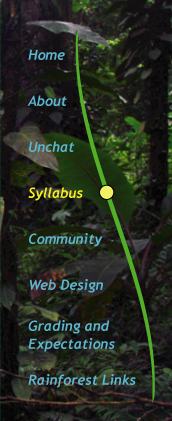


Home » Syllabus » Perspectives 1 » Perspectives 2 » Perspectives 3
Perspectives I: Scientific Research in Amazonia
In the Perspectives series, you are asked to read a series of brief papers or visit web sites to examine the different points of view of stakeholders in the problem of rainforest conservation in the Amazon. For your first assignment, you will examine some of the many kinds of research that take place in Amazonia in an effort to understand the past evolution and present condition of the ecosystem.
Our expectation is not that you read these documents and commit facts (and opinions!) to memory. Instead, think of them as stimulus to develop ideas of your own. In class on September 16, we will discuss the kinds of information you would like for scientists to be able to gather as part of your program to monitor the Amazon ecosystem, and we will brainstorm about how this information might be obtained, stored, categorized, and ultimately disseminated throughout the scientific community for analysis. Come prepared with a list of rainforest data sets that you'd like to see developed.
The title of each reference below (underlined) is a link to an on-line resource. Happy reading!
Fragments of the Forest (Natural History Magazine, July-August 1998). As civilization penetrates ever-more deeply into the rainforest, our roads fragment a once-contiguous wilderness into isolated pockets. How does the ecosystem adapt to such change?
The Matses Inventory (Natural History Magazine, September 2000). An important part of Mission 2006 is to devise a scheme to inventory species within the Amazon ecosystem, but how do professionals approach the problem. Other than plants (which at least tend to stay put!), some of the most easily inventoried species are mammals, right? Maybe not....
Determination of Deforestation Rates of the World's Humid Tropical Forests (Science Magazine, August 9, 2002). Earth-observing satellites have revolutionized the scale at which we can monitor ecosystems. To what extent will remote sensing figure into the Mission 2006 design?
Regional controls on geomorphology, hydrology, and ecosystem integrity in the Orinoco Delta, Venezuela (Geomorphology Magazine, May 2002). An important theme in Earth system science is that biological and geological processes are intimately related. Mission 2006 must recognize these linkages: in order to monitor the rainforest ecosystem effectively, observational strategies must focus on more than biology. In this technical paper, Warne and others review surface water transport processes in the Orinoco Delta and their influence on sediment transfer. Don't get bogged down by the jargon in this paper; read it casually to get a sense of the kinds of information that are necessary to understand hydrodynamic processes.